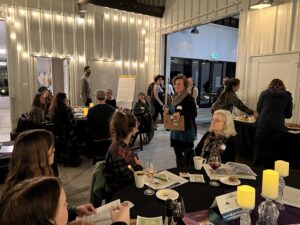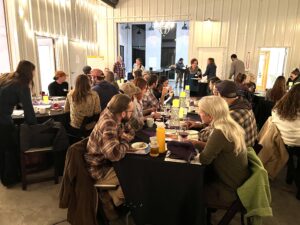Applegate farmers and food producers have been trying to join forces for years. Is this their moment?

“We’re honing in on action,” says AGA co-Director, Megan Fehrman.
by Christina Ammon
On November 7th, Applegate farmers and food producers gathered at the scenic event venue, Vista 222. The occasion was a working group meet-up organized by A Greater Applegate (AGA) and the Rogue Valley Food System Network (RVFSN). The timing was right and turn-out was good; with the fields now nipped by season-ending frost, there was time to put down the shovels and seeds and focus on flip-charts and strategy.
Their goal? To breathe life into some of the food and farm-related ideas outlined in the recently released Applegate Valley Vision Plan. The Vision Plan is a product of the dozens of listening sessions conducted by AGA over the past three years. Increasing connectivity between the farms and consumers was high on the list of priorities identified in the sessions.
 The group mingled and helped themselves to the buffet provided by Jefferson Farm Kitchen—a pitch-perfect menu of seasonal soups and rustic bread. It was a festive ambiance—there was a bottle of wine on every table–but make no mistake: They were there to get to work.
The group mingled and helped themselves to the buffet provided by Jefferson Farm Kitchen—a pitch-perfect menu of seasonal soups and rustic bread. It was a festive ambiance—there was a bottle of wine on every table–but make no mistake: They were there to get to work.
 “We are honing in on action,” announced Megan Fehrman, co-Director of AGA. This was the third Food and Farming meeting, with the first two focusing on listening and prioritizing. The question of the night was, “What could we do to maintain and enhance local agricultural food systems?”
“We are honing in on action,” announced Megan Fehrman, co-Director of AGA. This was the third Food and Farming meeting, with the first two focusing on listening and prioritizing. The question of the night was, “What could we do to maintain and enhance local agricultural food systems?”
The group was comprised of new arrivals, like Alec Lowe and Alexandria Love Schmidt from Earth Karma Land Sustainability and Rusty Bucket Gardens, and long-established farmers, like Don Tipping from Siskiyou Seeds and Maud Powell from Wolf Gulch.
“Some of us have been having these conversations for decades,” Megan acknowledged.

It was a festive ambiance–there was a bottle of wine at every table–but make no mistake: They were there to get to work.
“It could be tempting to get jaded,” said Maud Powell. But despite being part of similar efforts in the past with mixed results, she sees cause for hope. “Having a strong organization like AGA tackling these issues is the biggest difference. They clearly have the experience in food systems, rural development, fundraising and project management”.
The attendees sorted themselves among tables flanked by flip charts headed by different topics: increasing support for Farmers’ Markets; increasing local purchasing; land and water management; building relationships between producers and consumers; and increasing food system infrastructure. Written in bold on each chart: WHAT COULD WE DO?
Ideas filled the air as the groups began to identify ways to take action on each topic. At one table, Sara Marie Hamilton, the Applegate Valley Food and Farm Outreach Coordinator, led a discussion on how to connect producers and consumers.
Cassandra Olson, a real estate agent from Grants Pass, was at the table. She recalled moving to the valley and being unable to find information about where to buy local food; she ended up at the grocery store. This highlighted the need for a central communication system in the valley.
Lale Yasemin Kaya, from Suncatcher Food Forest, mentioned the need for consumer education. She noted that buyers can become disgruntled by local food prices. “They don’t know how much goes into producing one pumpkin, or how hard it is to grow lettuce in the heat of summer,” she explains. She said it would be good to train farmers on how to respond to pricing complaints.

Alec Lowe and Alexandria Love Schmidt are relative newcomers to the Applegate Valley. They run Rusty Bucket Gardens, which specializes in Rainbow Native Corn and Mountain Spinach. Alec also runs Earth Karma Land Sustainability, which focuses on regenerative farming methodologies.
At another table, AGA co-Director Seth Kaplan led a discussion on Farmers’ Markets. There are currently three markets in the valley, and they all struggle to maintain consistent customers and vendors. The idea was floated to offer financial incentives to vendors who sign up for all three markets. Someone also mentioned a need for on-site cold storage so farmers could drop their produce off at the market on their own schedule.
Other tables hashed out issues of water management and how to centralize local products for wholesale.
 No matter the topic, a common theme emerged: the problem of distance. There are not only geographic barriers between producers—farms are often miles apart–but there is also a lack of cohesion in the digital realm. Could there be a website, or app to centralize all of the farm information? There was also the task of psychologically unifying the Applegate. How could the valley build a brand identity to attract consumers?
No matter the topic, a common theme emerged: the problem of distance. There are not only geographic barriers between producers—farms are often miles apart–but there is also a lack of cohesion in the digital realm. Could there be a website, or app to centralize all of the farm information? There was also the task of psychologically unifying the Applegate. How could the valley build a brand identity to attract consumers?
None of these were new problems, and you could say they are intrinsic to the wide-open spaces of country living. Past efforts like the Siskiyou Sustainable Cooperative and Rogue Farm Corps have addressed these issues in different ways and to varying levels of success in the past, but challenges persist.
Commenting on the many ideas that emerged throughout the evening, Don Tipping said, “I could easily say ‘we tried that and it didn’t work.’ That doesn’t mean it’s not a good idea, though. We just didn’t have the social landscape that was receptive to it.”
He cited new digital and marketing tools that address some of the challenges, but said that it’s important the farmer doesn’t get stuck at the desk.

AGA co-director, Seth Kaplan, led the Farmers Market discussion table.
“Part of the rural terroir is that relationality is important,” he explained. “When you went to the Pennington Farms booth at the farmers market, you saw Cathy and her daughters—THAT was the draw. It was an authentic family farm experience. It was having an experience with a side of strawberries.” This type of connection is harder to maintain when the farmer winds up at a desk.
But overall, he was excited:
“I just texted two friends and told them they should have been here.”


Good job, all of you! I’ll watch how this develops as we have a need for central cohesiveness here in Ashland, Talent and Phoenix.